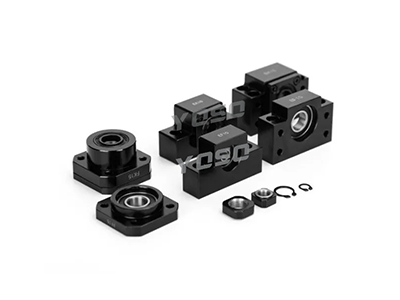Baintear gluaiseacht líneach thar ceann de shistéimí idirdhealaithe le ardhbhrúiscara. Chun cinntiú feidhmíocht éifeachtach agus stáitse, caithfear iad a úsáid le haicmí éagsúla cuidíochtaí. Cuimsíonn cuidíochtaí ardhbhrúiscara coitianta nascanna, cásanna maidin, cásanna taca, madaidh, agus cásanna mótar. Bíonn ról lárnach acu i bhforlíonadh struchtúrtha agus cruinneas idirdhealaithe.
1. Nasc
Is é an nasc atá mar nascadh idir deireadh an arbhair ardhbhrúiscara agus an arbhar aschuir mhótar seirbhó nó mótar céime. Coirreálann sé míshuiteáil fhorghoirt, istigh-an-iarraide, agus uillinn, absorpálann sé craos, agus laghdaíonn sé botún idirdhealaithe. Cuimsíonn cineálacha coitianta naisc dhíonra, naisc fhloinn phlúim, agus naisc cheallacha. Léiríonn naisc ardchaighdeáin trasdhealú glan agus cruinn.

2. Cás Maidin
Séanraíonn cás ailt an chuid ailt den ghortaire liathróide, ag cinntiú go bhfuil sé sábháilte suiteáilte ar bhanc oibre nó ar ardán inbheisteach. Tacaíonn sé leis an ngortaire, é a sheachaint ó lucht oirdheise agus cothú comhdhlúthacht cruinn idir an ngortaire agus an sceana. Meastaítear go minic airgead orm nó héagar asraon mar shaincheisteanna coitianta.

3. Aonad Tacaíochta
Tugann an t-aonad tacaíochta tacaíocht do dhá chríoch den ghortaire liathróide agus is minic a roinnteannar é i críoch fíksithe (cineálacha BK, FK) agus críoch tacaíochta (cineálacha BF, FF). Tá bearing uillinigh ardfhreagrach i gcás an chríoch fíksithe, ag soláthar suíomh oirdheise agus tacaíochta luchta, agus tugann an chríoch tacaíochta saoirse rothlaithe, ag cinntiú rothlaithe glan den ghortaire.

4. Gortaire Liathróide
Is é an alt an comhpháirt phríomha den scrua balla, agus é ag béileadh gluaiseacht rothaithe go ngléas lineach trí bhil acu a athroinneann. Glacann stíleanna éagsúla alta (mar shampla, fliang, solúbach, agus réamhlódáil dhá-alt) le háiteanna éagsúla suiteála agus riachtanais cruinneachta. Tionchar dhíreach atá ar fhreastail cruinn agus cruaibh a bhaineann le réamhlódáil agus leorán na hálta.

5. Basc Mótar / Socrú Mótar
Socraíonn an socrú mótar an mótar treochta agus cuannaíonn sé leis an gcomhdhúil scrua balla. Ligeann sé cothromaíocht idir mhéid an mhótar agus an scrua, ag cosc ar chruatacht agus ar ghuth a dhéanann easnamh. Cuireann socrú mótar ard-chruinneachta le feidhmniú stadta an chóimhidh tharchurtha iomláin.

Braitheann feidhmneacht córas sceana liathróid neamh amháin ar chruinneas mhaisithe an choirp sceana ach freisin ar chóiriú agus suiteáil cheart na n-ionchur ina theiligh. Is féidir cruinneas, staidiúlacht, agus fad saoil an chórais a fheabhsú go mór le roghnú ceart ar chónacháin, cromchabhlaí taca, cromchabhlaí na h-amaire, agus cromchabhlaí an imoir.
 EN
EN
 AR
AR
 BG
BG
 CS
CS
 DA
DA
 NL
NL
 FI
FI
 FR
FR
 DE
DE
 EL
EL
 HI
HI
 IT
IT
 JA
JA
 KO
KO
 NO
NO
 PL
PL
 PT
PT
 RU
RU
 ES
ES
 SV
SV
 TL
TL
 ID
ID
 UK
UK
 VI
VI
 HU
HU
 TH
TH
 TR
TR
 FA
FA
 AF
AF
 MS
MS
 SW
SW
 GA
GA
 CY
CY
 BE
BE
 KA
KA
 LA
LA
 MY
MY
 TG
TG
 UZ
UZ


